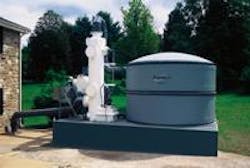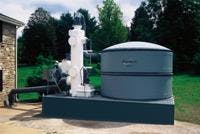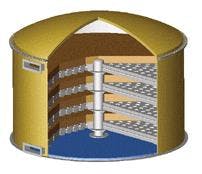Biofiltration System Solves Pump Station's Odor Problem
Engineering management at Baltimore County's 10 mgd Long Quarter pumping station reports it has taken advantage of a new, closed biofiltration system to solve a long running, major odor problem. In addition to ending complaints from the community, the system provided the extra advantages of ending chemical costs for odor control for the pump station, while requiring only a 12' x 20' footprint that made it easy to locate on a property where convenient accessibility to numerous underground structures had to be maintained.
The BMF-12 Biofilter System was designed, manufactured, and installed by Biocube Inc. of Victor, NY. The company also provided startup and testing services.
"Since the startup phase was completed last October, we've not only never gotten a complaint from anyone in the area, but local residents have stopped by to say how happy they are that we installed it," said John Krysztofiak, mechanical engineer for the county's 110 sewage pump stations.
"It's a closed system that gives us the opportunity for temperature and humidity control that we couldn't get with open system alternatives. And our hydrogen peroxide treatment, which we use for both odor control and corrosion prevention, has been ended for odor control for this pump station. Meanwhile, the system could be installed on a very small footprint, allowing us to maintain easy access to pipelines, electrical conduit, manholes, vaults, and other underground structures that are on the same property."
Long-standing Problems
Krysztofiak, who started in his position in 1990, said that the odor problem at the station "was always there," with complaints mounting each year.
When a concrete pipe downstream of the station failed in 1997 due to sulfuric acid corrosion, a consulting firm was retained to recommend ways to prevent sulfuric acid formation from hydrogen sulfide and also control odors. After considering "five or six" alternative solutions, the firm recommended hydrogen peroxide treatment to solve both problems.
"They treated this station, which was built in the mid-1970's, and another one upstream, at the rate of 50 gallons per day each, and it didn't solve the problem," Krysztofiak said. "They increased the dosage to the maximum level allowed by the pumps, and then installed new pumps, at a cost of $10,000, to raise the dosage to 300 gallons per day at each station to prevent hydrogen sulfide from forming at both the stations and in the pipelines. Even at those quantities, they were not getting the gas below 1 ppm, or even 10 ppm."
While that didn't matter much at the upstream station, which was at a landfill producing other odors and with no residences nearby, the Long Quarter station is on a property sloping down to a 15 foot drop from street level. It gets quite humid there in the summertime, and the wetwell design didn't allow for exhaust of fumes as high as staff would have liked.
"When fresh air was vented in to allow for maintenance entrance," Krysztofiak said, "the exhaust out would cause complaints from homes as far away as 300-500 feet. The county tried an orange mist-type masking agent that was supposed to produce a citrus smell, but still got odor complaints. Now, with the Biocube installed, none of the sewage gases escape."
"Our operating cost for the masking agent has already been eliminated, and we're hoping we'll also be able to see a reduction in our hydrogen peroxide consumption, which currently runs us about $250,000 a year. But we're not doing this to save money — we may still need the same level of hydrogen peroxide for odor control and corrosion prevention for the pipeline downstream."
"We're doing this to solve an odor problem that was putting a lot of pressure on us from the community. We do know that we won't ever need chemicals for odor control at a pump station where we have a Biocube unit in place. We're hoping another product they have, manhole inserts with their biological media, will allow us to add manholes to the types of locations we can control without chemicals."
Krysztofiak reported that for very small pump stations, up to 1/2 mgd, the county also had experience with granulated activated carbon (GAC) canisters for odor control, and was unhappy with having to replace them in less than a year. They then started using open-type, mulch bed systems, with a fan drawing air from the wet well and forcing it through the mulch, but found they didn't have enough control to deliver sufficient results. They were not aware of any effective technology for the larger pump stations, with operating ranges as high as 20-30 mgd, aside from locating far away from houses and exhausting as high as possible.
"It was after a pre-bid meeting for a new station in the spring of 2001 that Biocube's local rep introduced us to his closed-type biofiltration technology," Krysztofiak said. "We were interested right away, and began extensive work with Biocube's management. While we were working at getting them in, they completed their development of this new product, which allowed us to establish a footprint for only one 12 foot diameter vessel, instead of six of their 6 foot diameter units. This not only allowed us to maintain the underground access we needed on the property, but to make the system much easier to fence in when we move it to its permanent location. And the compact, skid-mounted format will allow us to lift and relocate by crane with only a one day outage."
The skid-mounted system consists of a biological media vessel, a moisture integrator, a fan, a dewatering device, and a carbon polishing unit. The moisture integrator includes a heated, water-filled sump and a recirculating pump to maintain the highest possible activity and efficiency from the bacteria in the media. The fan, located at the discharge of air from the wet well, is preceded by the dewatering device, which drains back to the wet well. The carbon polisher unit helps maximize the more than 99% hydrogen sulfide removal provided by the patented media.
The vessel is designed for easy media replacement. The media can deliver a 3-5 year service life.
"We're not worried about the longevity of the caustic-impregnated carbon," Krysztofiak said. "We expect it to last for years because it's removing only small amounts, and it helps with other kinds of odors we get because of input from sources like a spice company that discharges into our system."
The Biocube system also allows staff to vent the pump station without worrying about odor complaints.
"Previously," Krysztofiak said, "we were inhibited from doing the ventilating we needed to do to allow maintenance access to the pump station, because the exhaust would cause odor complaints. Now we can ventilate the way we want without fear of that, and consequently increase the service life of valves, piping, sluice gates, and other equipment."
Krysztofiak said Biocube helped him test the system's effectiveness for reducing hydrogen sulfide release by artificially introducing bottle hydrogen sulfide gas to imitate summertime conditions.
"It was already getting cold outside, reducing hydrogen sulfide levels naturally, when we started testing," he said, "and we also had to account for different levels of venting. In the colder months, with venting off because of the odor problem, we were averaging 30-40 ppm, with spikes around 90-100 ppm. And in the summertime, still without ventilation, we could expect spikes of 200 ppm or more, so we added the gas artificially to bring it up to that level for testing purposes."
"With proper ventilation now possible, spikes will probably not exceed 100 ppm, making us very confident of summertime effectiveness, while we know we can have a comfort level with up to 200 ppm or more."
Given the size of the wet well and an air exchange rate of four air changes per hour, the Long Quarter system was designed to handle an air flow rate of 1000 cfm. Comprehensive testing, covering a range of inlet and exhaust temperatures, demonstrated excellent performance during winter, with simulation of summer conditions proving the system to be more than adequate to achieve 99% removal of hydrogen sulfide under worst case concentrations, including spike loading.
The system installed at the Long Quarter site, a 4-media layer type, is rated for removal of average concentration of 100 ppm hydrogen sulfide, with spikes up to 200 ppm. A five-layer type is offered by Biocube for removal of average concentration of 250 ppm, with spikes to 1000 ppm. Two- and three-layer models are available for lesser concentrations. In a separate extrapolation of test results from the site, using published theoretical guidelines, Biocube has demonstrated increasing media temperature as a means for allowing degradation of long-term spikes.
The vessel and its accompanying humidifier subsystem were found to be well insulated against ambient temperature changes, with no need indicated to further insulate pipes to avoid decreased media temperature and consequent potential loss of removal efficiency. The humidifier provided for rapid and precise control of media temperature in the range of optimum metabolic hydrogen sulfide removal.


